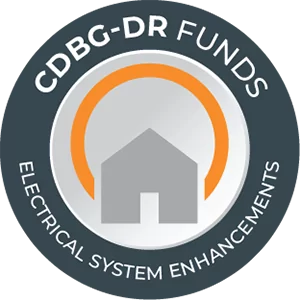
Electrical System
Enhancements
More than five years have passed since hurricanes Irma and María impacted Puerto Rico in September 2017. Due to the vulnerability of the electric power system, the impacts caused by both hurricanes remain ever present in the daily lives of the Island’s residents. Energy service interruptions are common and unpredictable, energy consumption costs continue to rise, and insufficient generation and faulty substations are common. In addition, Puerto Rico’s location within the Caribbean region puts it at severe risk to the consequences of climate change.
The hurricanes had a devastating impact on the electrical system and resulted in the longest sustained blackout in modern U.S. history. The prolonged disruption of electrical service prevented residents from accessing other essential services such as healthcare, communications, refrigeration, water, ventilation systems, air conditioning, and security. Due to a sustained systemic instability, residents continue to face many of the same challenges. Economic recovery has become difficult to achieve and the restoration cycle remains incomplete. Energy remains the single most comprehensive and critical factor to the future of the Island.
Current Challenges:

Electrical grid conditions

Increase in costs and pricing for construction materials

Shortage in skilled labor

Recovery efforts after María were entirely focused in restoring electrical service

To help address these challenges, the U.S. Department of Housing and Urban Development (HUD) has granted a special allocation under CDBG-DR funding (CDBG-DR Energy) for electrical power system enhancements and improvements for Puerto Rico. The allocation’s objective is to relieve the financial burden caused by the electrical power system’s recovery efforts and address the system’s reliability and resiliency needs.
In 2018, the Island received $9.7 billion in CDBG-DR Funding and in 2020, an additional allocation of $277 million to serve persisting needs. On June 22nd, 2021, HUD announced a funds assignment of $1.93 billion for the exclusive use of improving Puerto Rico’s electrical system.
These funds provide a unique and significant opportunity to carry out strategic and high-impact activities that:
- Address necessary electric power system recovery expenses;
- Mitigate the electric power system’s risk to future disasters;
- Improve the electric power system’s reliability, resiliency, efficiency, and sustainability; and
- Address the electric power system’s long-term financial viability.
The Puerto Rico Department of Housing (PRDOH), as the grantee of the CDBG-DR Energy funds, is responsible for administering these funds. As described in PRDOH’s CDBG-DR Electrical Power System Enhancements & Improvements Action Plan, the funds will be used for the implementation of two programs focused on supporting the Island’s electric power system’s improvements strategy:
On March 25th, 2022, HUD partially approved the Action Plan, allowing the Electrical Power Reliability and Resilience Program (ER2) to move forward with planning, design, and implementation.
Energy Grid Rehabilitation and Reconstruction (ER1) Cost Share Program
- Objective: Energy Grid Rehabilitation and Reconstruction (ER1) Cost Share Program.
- Budget: $500M.
- Grants: A 10% nonfederal match is required for energy systems’ recovery.
- Current Status: PRDOH is collecting specific information required by HUD before being able to implement this Program.
- Next Steps: Once HUD evaluates the information and approves the Action Plan in its entirety, the design and planning stages of the Program will commence.
- Eligibility: Eligibility to receive funds under the Energy Grid Rehabilitation and Reconstruction Cost Share Program is determined upon projects that have been considered eligible by FEMA or by any federal agency acting as the primary resource of funding to participate in the Program.
Electrical Power Reliability and Resilience Program (ER2)
- Objective: Provides assistance in the process of building a reliable and resilient energy system that will serve communities more efficiently.
- Budget: $1.3B
- Grants: Minimum allocation of 5 million dollars.
- Current Status: On February 3rd, 2023, a Subrecipient Agreement was signed with Puerto Rico’s Medical Services Administration (ASEM) to build a microgrid that will serve Centro Médicos’s medical facilities.
- Next Steps: In February 2023, the Department of Energy (DOE) and its National Laboratories will train PRDOH in the prioritization of strategic projects focused on the creation of microgrids.
Afterwards, a competitive application period will open and eventually, the grant execution and contracting for the Centro Médico Microgrid developer. - Eligibility: Agencies, Authorities, Trusts, and Boards of the Government of Puerto Rico (focused on projects that support energy systems enhancements); Public private partnerships as defined by Act 29-2009, as amended, better known as “Public Private Partnerships Act”; Units of local general government, local and municipal governments (including departments and divisions) (focused on projects that support electrical systems enhancements); For profit businesses (focused on projects that support electrical systems enhancements); Healthcare systems and public hospitals; Nonprofit entities that comply with the established requirements of capacity and experience

Energy Grid Rehabilitation and Reconstruction Cost Share Program (ER1) |
|
|---|---|
|
Objective |
|
| Covers the allocation’s nonfederal costs without FEMA PA precedents for a PREPA Island wide project under FEMA’s FAASt strategy. | |
|
Budget |
|
| $500M | |
|
Grants |
|
| A 10% nonfederal match is required for energy systems’ recovery. | |
|
Current Status |
|
| On March 30th, 2023, HUD fully approved CDBG-DR Electrical Systems Enhancements and Improvements Action Plan Amendment #1, allowing PRDOH to move forward with program planning, design, and implementation. | |
|
Next Steps |
|
| Once HUD evaluates the information and approves the Action Plan in its entirety, the design and planning stages of the Program will commence. | |
|
Eligibility |
|
| Eligibility to receive funds under the Energy Grid Rehabilitation and Reconstruction Cost Share Program is determined upon projects that have been considered eligible by FEMA or by any federal agency acting as the primary resource of funding to participate in the Program. | |

Electrical Power Reliability and Resilience Program (ER2) |
|
|---|---|
|
Objective |
|
| Provides assistance in the process of building a reliable and resilient energy system that will serve communities more efficiently and address unmet needs tied to electric service. | |
|
Budget |
|
| $1.3MM | |
|
Grants |
|
| Minimum allocation of $5,000,000.00 Eligible public entities may receive up to 100% funding for the capital costs of a project. Eligible private entities may receive up to 60% funding for the capital costs of a project. The remaining 40% must come from non-CDBG-DR Energy source and be secured by the entity. | |
|
Current Status |
|
| ER2 Program design and implementation are underway. On February 3rd, 2023, a Subrecipient Agreement (SRA) was signed with Puerto Rico’s Medical Services Administration (ASEM) to build a microgrid that will serve Centro Médico’s medical facilities. The RFP for the Centro Medico Microgrid project was published on February 10th, 2023. | |
|
Next Steps |
|
| In collaboration with U.S. Department of Energy (DOE) and its National Laboratories as our technical assistance partners, as well as other critical Puerto Rico Government and energy sector stakeholders, PRDOH will identify and select strategic projects for funding. The Centro Medico Microgrid project is one such strategic project that is currently in the procurement phase, with contract execution with the chosen developer expected by the end of 2023.Additionally, the Program’s Competitive Application period will open in summer 2023. | |
|
Eligibility |
|
|
|
Approach for the Use of Energy Resources
- Key Principles:
- Renewable Energy – Maximize the integration of renewable energy sources to reduce the impact of climate change and reliance on fossil fuel technologies.
- Distributed Energy Resources – Promote Distributed Energy Resources, like new power generation assets close to load centers and energy storage systems, for a decentralized and resilient electrical power grid.
- Vulnerable Populations and Services – Focus on addressing the most vulnerable populations and critical services
- Additional Considerations:
- Data Driven Approach – Utilization of data to guide Program design and implementation.
- Stakeholder Engagement – Engage with communities, groups, and other key stakeholders to promote stakeholder-informed decision-making.







